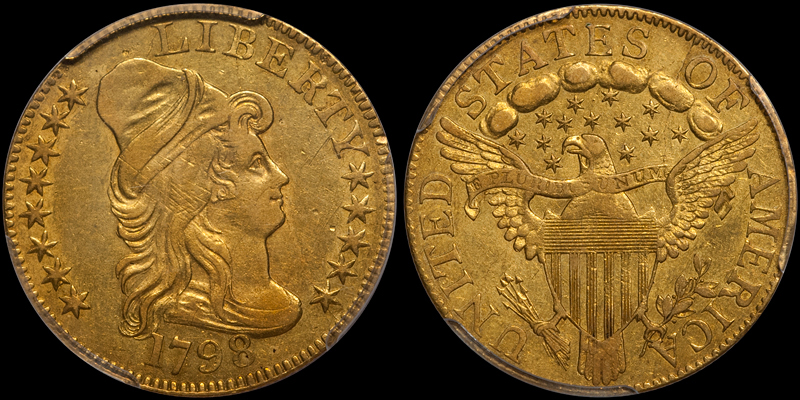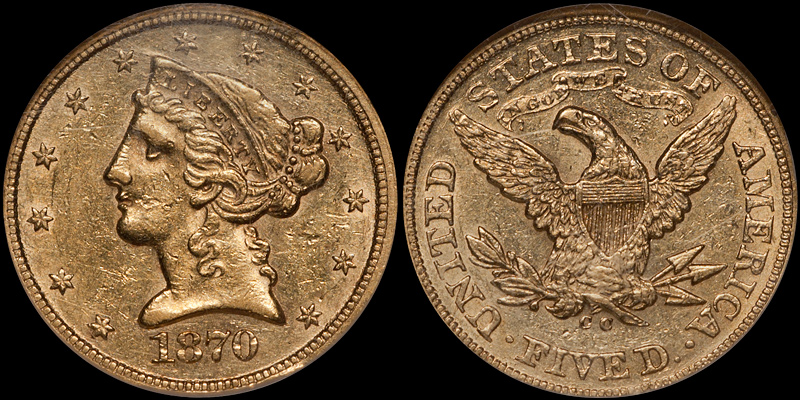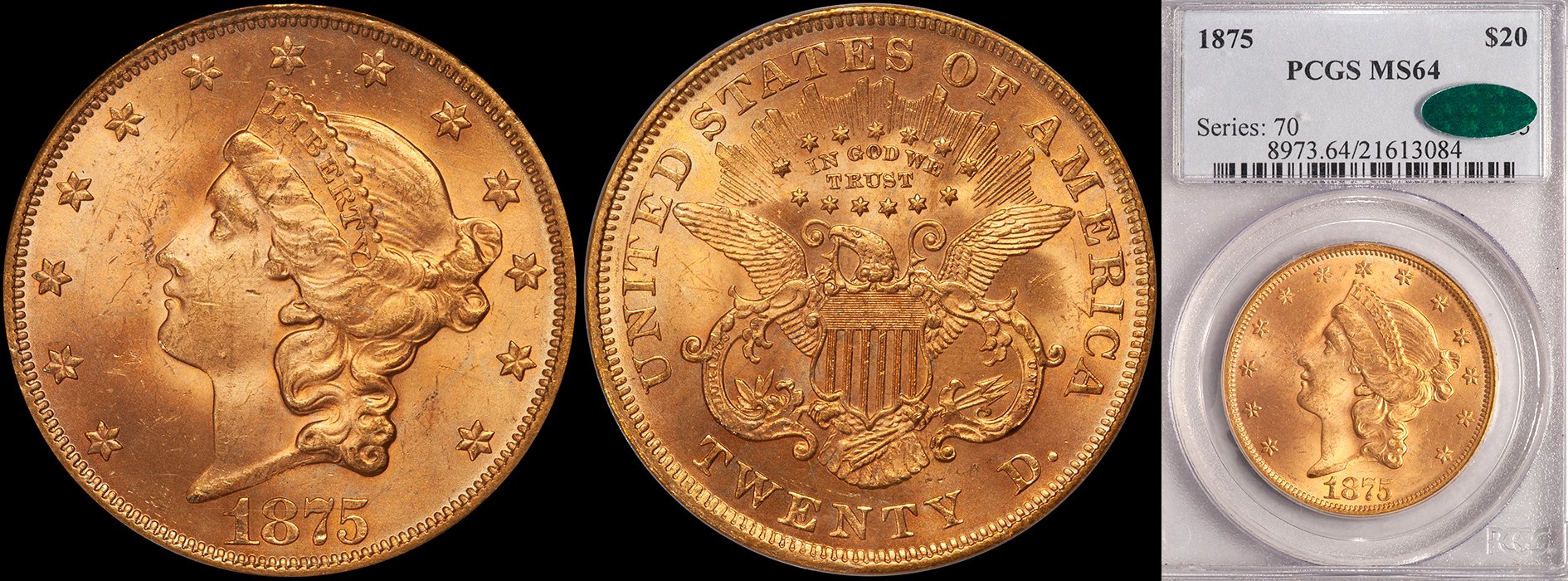Ten Reasons Why Fives Are the New Tens, or: A Love Letter to Half Eagles
/Half eagles aren’t my favorite denomination per se but, from a collecting point of view, they make a lot of sense to me and on many different levels. If we look at the various gold denominations from a macro perspective, I think it’s safe to say that double eagles are the most popular. They are big and their bulk appeals to the Scrooge McDuck part of everyone who collects gold. But true rarity in this denomination is costly and unless you are able to write a check for at least $7,500-10,000 per coin, you aren’t likely to buy many coins which are rare in the truest sense of the word.
The high price of double eagles gave life to the Liberty Head eagle series. As recently as five or six years ago, there was amazing value throughout this series, but many of these former good deals have risen in price as demand has increased. You can still buy some pretty nifty Ten Libs for $5,000 or so, but the opportunities to do so are fewer and fewer with the passing of every year.
Which leaves us with the half eagle. In my opinion, the size of this coin is just about perfect (confession: when it comes to silver, I like the quarter dollar as the “right” size). In the early gold series I like the size of the half eagle better than the quarter eagle or the eagle, and in the Liberty Head series, I like the size and the collectability factors. In the 20th century, I like the Indian Head half eagle both for its unique incuse design and its challenge of completability. (More on these points as we progress through the course of this article.)
1. Variety is the Spice of Half Eagle Life
1795 Small Eagle $5.00 PCGS EF45 CAC
With nine major types (as well as a number of interesting subtypes which can be added), the half eagle denomination offers more variation than any other gold denomination. Half eagles were made from 1795 through 1929 and the following major types are known:
Capped Bust Small Eagle, 1795-1798
Capped Bust Heraldic Eagle, 1795-1807
Capped Bust Left, 1807-1812
Capped Head Left, large diameter 1813-1829
Capped Head Left, reduced diameter 1829-1834
Classic Head, 1834-1838
Liberty Head No Motto, 1839-1866
Liberty Head With Motto, 1866-1907
Indian Head, 1908-1929
While a few of these types are rare and expensive (most notably the Capped Bust Small Eagle and the reduced diameter Capped Head Left, none are out of reach and most can be found in comparatively high grades. For the variety collector, the half eagle is an extremely interesting denomination.
2. Multiple Mints
1843-O Large Letters $5.00 NGC MS64+ CAC
In the 138 years in which classic United States gold coins were produced (1795-1933) a total of seven mints were in operation. Only one denomination—the half eagle—was made at all of these. The seven mints and their dates of operation are as follows:
Carson City: 1870-1893
Charlotte: 1838-1861
Dahlonega: 1838-1861
Denver: 1906-1931
New Orleans: 1838-1909
Philadelphia: 1793-1933
San Francisco: 1854-1930
The so-called “seven mint set” of half eagles can be assembled using the Liberty Head type. None of these seven mints are rare or expensive (except in comparatively high grades) and a nice EF/AU set can be put together for under $10,000. A really nice AU55/58 to Mint State set can be assembled for around $30,000.
3. The Appearance Factor
I like coins which have good eye appeal. This means I tend to not like weakly-struck coins or coins which have numerous abrasions from being shipped loose to banks or overseas. Smaller denomination coins tend to show irregular strikes (hello, Dahlonega quarter eagle) and larger coins tend to be bag-abraded or scuffy (I’m looking at you, O mint double eagle). Half eagles tend to be well made and do not generally have the appearance issues which plague their larger counterparts.
Charlotte and Dahlonega half eagles tend to be much more cosmetically appealing than the gold dollars and quarter eagles from this mint. While I personally find the folky quality of an 1857-C dollar or an 1856-D quarter eagle to be endearing, I can see how many collectors would rather have a well-made coin like an 1841-D half eagle or an 1852-C half eagle in their collection.
4. Early Gold: Sticker Shock
Let’s say you want to dabble in early gold. You have a budget of around $10,000 per coin and you are concerned with eye appeal. Your ten grand will buy you a damaged POS in the early eagle arena, and it will buy you a very mediocre VF/EF example of the most common types of quarter eagle. In other words, a pretty hefty sum will get you nowhere.
1813 $5.00 PCGS AU55 CAC
This isn’t the case in the field of early half eagles. A ten thousand dollar early half eagle can be downright exciting. You will be able to afford a very presentable AU example of an early 19th century Capped Bust Right Heraldic Eagle and an equally spiffy Capped Bust Left. And you can even afford a nice 1813 Capped Head Left, one of the rarest of the five types of pre-1834 half eagles. If you want to include the Classic Head type as “early gold” (which is technically isn’t but we can make an exception for you…) you can buy all sorts of groovy coins for $5,000. $10 grand? That will buy you amazing coins in the Classic Head series including such delicacies as the first year of issue/one year types from 1838-C and 1838-D.
5. Indian Head Half Eagles: Some Thoughts
In my opinion, Indian Head half eagles are the least understood and least appreciated of the four 20th century gold types. The Indian Head quarter eagle set can be assembled in a few months, given the availability of the coins, and the Saint Gaudens set is crazy expensive in MS64 and higher. This leaves us with the Indian Head half eagles and eagles. Given the fact that the 1933 is out of the price range of most collectors and a nice 1920-S eagle is costly, the Indian Head half eagle series might be a better bet.
1908 $5.00 Indian PCGS MS65 CAC
I personally find this series fascinating for a number of reasons. The first is that even the common dates are genuinely scarce in MS65 and above; far more so than any other of the post-1907 U.S. gold types. Second is the fact that so few really great collections of Indian Head half eagles have been formed; and when they do get completed, they seem to be sold immediately after completion. Third is the challenge that this series presents for the very well-heeled collector. There are a number of dates which are exceptionally rare in MS65 and which are genuinely scarce even in grades as low as MS63. This is not a series which I’d suggest be attempted in circulated grades. In my opinion, a circulated Indian Head half eagle tends to be ugly and, ironically, the more original dirty coins are even uglier than their processed brethren.
6. Naming Names: The Undervalued Dates
1798 Small 8 $5.00 PCGS EF45
There are so many undervalued dates in the various Half Eagle series, it’s hard to limit the number to 20. So I’m going to limit it to this number, but throw out the caveat that I could easily stretch this list out to 50 coins.
1798 Small 8
1806 Pointed 6
1808/7
1818 5D/50
1837 1840-O
1842 Large Letters
1848-D/D
1854-C Strong C
1855-D
1855-O
1858-S
1859
1864
1872
1876-S
1878-CC
1883-CC
1892-O
1904-S
7. Some Out of the Ordinary Ways to Collect Half Eagles
The majority of half eagle collectors are specialists who either collect by date or by type. It’s hard to argue with these tried and true methods, but let me make a few out of the ordinary suggestions on how to collect half eagles.
1807 Bust Right $5.00 PCGS MS62
a) Transitional collecting. A transitional issue occurs when two distinct design types are produced during the same calendar year. In the half eagle series, we have the following:
1795 Small Eagle and Heraldic Eagle
1797 Small Eagle and Heraldic Eagle
1798 Small Eagle and Heraldic Eagle (note: the Small Eagle issue is exceedingly rare)
1807 Capped Bust Right and Capped Bust Left
1829 Capped Head Left large diameter and 1829 Capped Head Left reduced diameter (note: both types are very rare)
1834 Capped Head Left and Classic Head
1842 Liberty Head Large Letters and Small Letters
1866-S No Motto and With Motto
1908 Liberty Head and Indian Head
These nine transitional issues, representing 18 different coins, would make for an amazing (albeit very expensive) collection.
b) Interesting years. There are certain years during which either interesting varieties of half eagles were produced, or a number of low-mintage issues were struck, or the date is reflective of some important historical event.
1861-D $5.00 PCGS EF45 CAC
I can think of a number of years which would make for interesting, specialized collections. One which quickly comes to mind is the 1795 because of its status as a first year of issue, and the many die varieties produced. Some of the more practical years to specialize in include the following:
1840: Four mints struck coins and both narrow mill and broad mill varieties exist for Philadelphia and New Orleans half eagles.
1842: A total of seven different issues exist from four different mints. This is an interesting transitional year (see above) and Large Date/Small Date and Large Letters/Small Letters varieties exist.
1846: At least six major varieties are known from four mints including the interesting 1846-D/D and a Large Date/Small Date tandem from Philadelphia.
1855/1856/1857: Five mints produced half eagles during these three years and all of these issues are within the budget of most advanced gold collectors (note: five half eagles were struck in 1854 as well but the San Francisco issues is exceedingly rare).
1861: Final year of issue for the Charlotte and Dahlonega issues.
1866: Important transitional year (see above).
1870: First year of issue for Carson City
1892: Resumption of coinage at New Orleans; four different mints made half eagles for the first time since 1861.
c) Multiple Levels of Demand. A multiple level of demand coin is an issue whose level of demand comes from multiple sources. As an example, an 1838-D half eagle is sought by date collectors, type collectors, first year of issue collectors, and generalists who like neat coins. Compare these numerous levels of demand to an 1854-D half eagle whose demand is limited to date and type collectors.
1870-CC $5.00 NGC AU58
Some of the half eagles with the highest multiple levels of demand include the following:
1795 Small Eagle: first year of issue and one of the two gold coins struck first by the United States
1838-C and 1838-D: first issues from the Charlotte and Dahlonega mints and one year types
1861-C and 1861-D: final issues from the Charlotte and Dahlonega mints and coins with Civil War tie-ins
1870-CC: first issue from Carson City
1887: rare Proof-only date
1929: final year of issue for the half eagle denomination
8. Grades: How Low Can You Go?
Until a few years ago, I almost never bought gold coins for stock which graded lower than EF40. But a conversation at a Baltimore show with a collector of lower grade rarities changed my perspective. And no series saw a greater change in my buying habits than Liberty Head half eagles.
Part of my reasoning for suddenly “liking” lower grade Five Libs is aesthetic; this denomination/design actually looks visually appealing in lower grades, unlike gold dollars and three dollars which look lousy (in my opinion) below EF. The only other gold denomination which is sometimes seen in lower grades is the quarter eagle and, for some reason, half eagles just look better in VF20 than their smaller counterparts (eagles and double eagles are not often seen in lower grades as they tended to not circulated as extensively as quarter eagles and half eagles).
I don’t mean to give you the impression that a VF20 1862-S half eagle is more impressive to me than an EF45 example of another slightly less rare date. But if said 1862-S is clean and evenly worn, it likely has more pleasing surfaces (albeit with less detail) than its higher grade counterpart. With a coin like the 1862-S, which is extremely rare in higher grades and which, when it is found in AU tends to be really ugly, I might like the VF coin better because it is less schlocky.
9. Pay to Play
If your budget is around $5,000 per coin you can get a lot of bang for your buck in the No Motto half eagle series. Let me give you a few examples:
$5,000 will buy you an extremely appealing AU55 to AU58 Charlotte or Dahlonega half eagle from the 1840’s or 1850’s.
$5,000 will buy you a very nice AU55 to AU58 New Orleans half eagle which will likely represent one of the top 10-15% known of an issue with a surviving population of less than 150-200 coins.
$5,000 will buy you an MS63 common date Philadelphia with all the bells and whistles. This coin may not be a mega-rarity but it is likely to be cosmetically appealing. And such a coin will always seem like a good value compared to the 7x to 8x jump in price for a Gem.
$5,000 will buy a presentable example of a truly scarce date like an 1842-O or an 1858-S; two issues which have fewer than 100 examples known in all grades.
There are not many other larger-sized Liberty head denominations where five grand lets you play in the deep end of the pool.
10. Some Thoughts on Proofs
I’ve been fortunate to handle some great Proof half eagles over the years, and what I like about these coins (both Liberty Head and Indian Head) is that they are the largest denomination a collector or investor can buy in really spectacular condition (PR65 DCAM and above) for a respectable price. $40,000 will buy you a fabulous Gem from the 1890’s. $60,000+ will buy you an original non-conserved, CAC approved Gem Indian Head type.
1892 $5.00 PCGS PR66 DCAM
Compare this with the steep freight you will have to pay if you collect Proof eagles or double eagles. A Gem Proof Liberty Head eagle cost around 50% more than a half eagle (and is considerably more difficult to locate) while a non-conserved, Gem Proof CAC Indian Head eagle may prove hard to find at less than $100,000. And unless you make hedge fund manager kind of money, a Gem Proof double eagle of either the Liberty Head or St. Gaudens types is likely out of the question.
So there you have it…2500 words of random thoughts on a denomination which has become a favorite of mine. Would you like some assistance in putting together a nice collection of half eagles? Feel free to contact me at dwn@ont.com and remember to leave your comments below.
Do you buy rare gold coins?
Do you have coins to sell?
Would you like to have the world’s leading expert help you assemble a set of coins?
Contact me, Doug Winter, directly at (214) 675-9897 or by email at dwn@ont.com.


















